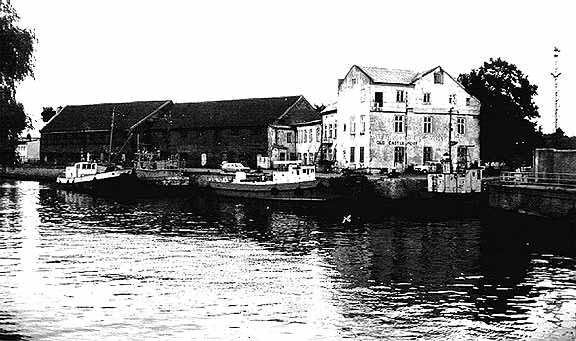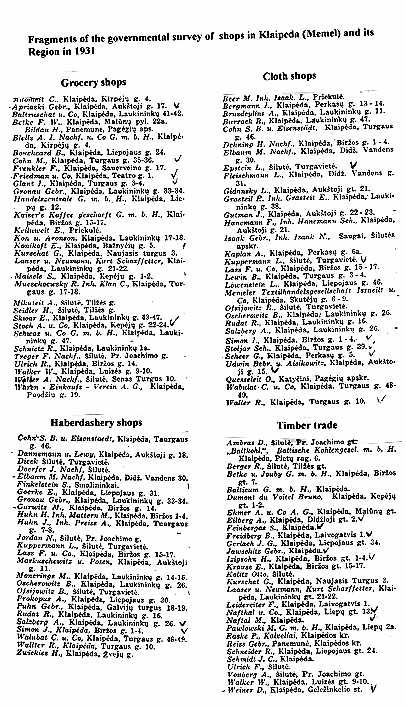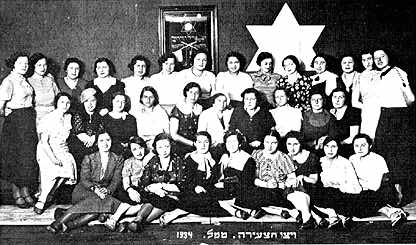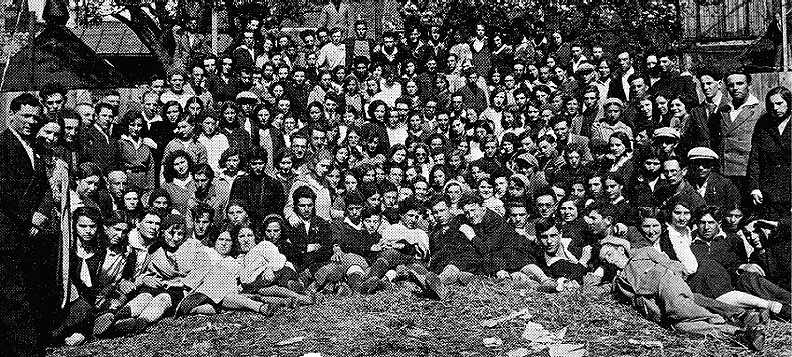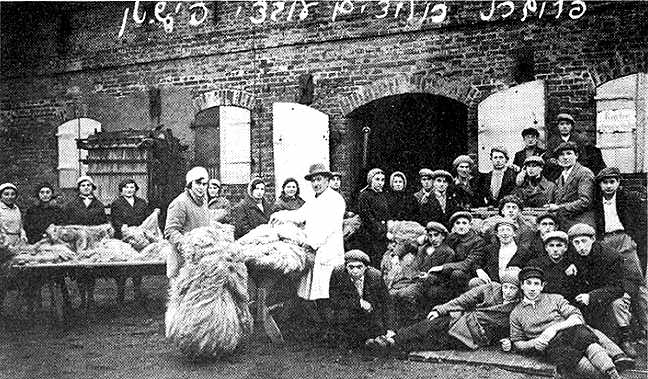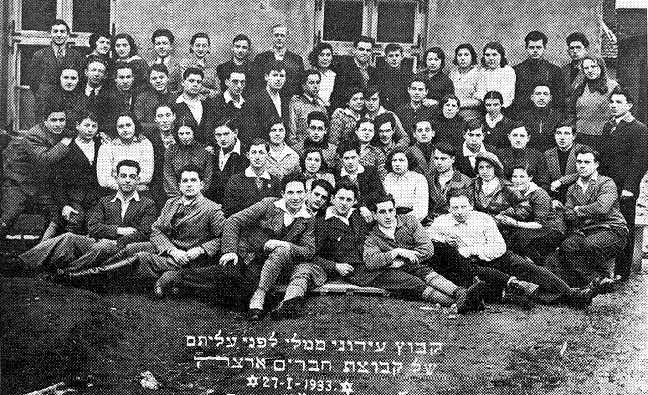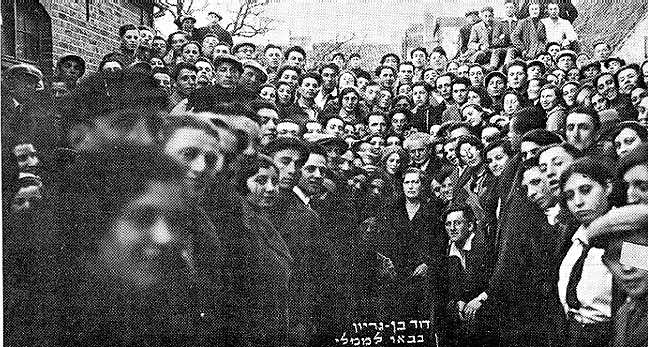Between the Two World Wars
The French Governor, who ruled the region on behalf of the Entente, cancelled all restrictions which had been imposed upon the Jews, and thus all the Jewish inhabitants of Memel and the region received citizenship. The Governor nominated a committee of four members, two of them Jews, Moritz Altschul and Leon Rostovsky, as well as one German and a French officer as chairman, to deal with requests for citizenship, as a result of which the number of Jews in Memel increased quickly. The port, the developing commerce, the convenient conditions for developing industry, the possibility to learn a trade and the easing of permission to leave for the west and to Eretz-Israel, motivated many Jews to settle in Memel. The Lithuanian Government, having annexed Memel and the region to Lithuania in 1923, was pleased with the increase of the Jewish population, because the Jews together with the Lithuanians reduced the influence of the German majority. The number of Jews in Memel in 1910 was 2,000 out of a total population of 21,108 (9%), and by 1928 there were 4,500 Jews, in 1938 - 6,000 Jews (12%) and in 1939 - 7,000 Jews out of a total population of 51,000 (about 14%).
The Klaipeda Port on the Dane river Doctors who held German diplomas moved from Lithuania to Memel and local Jewish lawyers became judges and prosecutors. Among the 21 judges in the city, 7 were Jews and one Jew became a prosecutor, but at the end of 1938 there were only 3 Jewish judges and one Jewish prosecutor left, while their German colleagues plotted against them.
The legal basis for the existence of the Jewish community during this period was still the Prussian law from the 23rd of July 1847 (see above) with additions which the "Directory" approved, i.e. the autonomic rule of the region established on the 28th of July 1924. Officially the "Directory" supervised the activities of the Jewish community, which meant that Rabbis, slaughterers and other employees of the community received their salaries and pensions from the "Directory" similar to the employees of the Christian churches in the region. The "Directory" consisted of 16 members, 8 of whom were elected anew every year, and in 1936 2,000 Jews were registered in the community. Only 900 Jews voted for the "Directory" during the elections of that year, 200 of them voting for the list of "Agudath Yisrael". Memel's Jews were not too active or interested in the activities of the community and this explains the small number of participants in the elections.
Conditions of the Jews of the region were considerably influenced by friction between the Lithuanian ruler and the German population who were in the majority. In 1933, for example, there were 4,510 Lithuanians as opposed to 14,632 Germans in Memel.
When the Nazis came to power in Germany, they began agitating for the region to return to Germany. In 1935 Memel Nazis were convicted of hooliganism, as a result of which the German press wrote that they were victims of a Jewish conspiracy because they were judged by Jewish judges and Jewish prosecutors. In 1937 Nazi youngsters harmed Jewish vacationers in Schwartzort (Juodkrante), a summer resort on the Baltic Sea and the Kurisches Haff. In that same year 10 Jewish students of the School of Commerce and the Pedagogic Institute in Memel suffered from insults and scheming from Lithuanian students. Although the Lithuanians ought to have been interested to oppose such deeds, they were too influenced by Nazi propaganda. During the second half of 1938 the situation of Memel's Jews deteriorated, with Nazis painting swastikas on Jewish shops and even placing bullies outside Jewish shops to prevent buyers from entering. At a gathering of Nazi activists in Memel, they demanded the activation of anti Jewish "Nuerenberg Laws".
In the elections of 1938 to the local Seimas, the Nazis received an absolute majority.
The Jews were asked to vote for Lithuanian lists (see poster below).
By the beginning of 1939 half of Memel's Jews had left the city and moved to towns in the western part of Lithuania (Zemaitija), such as Palanga, Kretinga, Jurbarkas, Taurage and to Kaunas. The value of the property the Jews took with them from Memel was estimated at 100 Million Litas (1$ was then 6 Litas). Others sold their property to Germans for low prices, but when it became clear that the city and the region would soon be annexed to Germany, all Memel Jews moved to Lithuania in a panic, leaving their property behind. Transportation became so crowded and prices soared, causing poor Jews to go by foot to the nearby Lithuanian town of Gargzdai. The Jewish communities helped the refugees to get organized in their new abodes.
In Shavl (Siauliai), Telzh (Telsiai) and Tavrig (Taurage) sick refugees were treated free of charge in the clinics of the "Oze" organiztion, the children of the refugees were accepted in the schools and high-schools. and the "Oze" organization supplied food for weak and poor children.
A Jewish family fleeing from Memel on the 21st of March 1939, uniformed Nazis standing by.
On the 22nd of March 1939 the German army occupied Memel and the region. By that time about 21,000 people had left the city, most of them Lithuanians as well as a small number of Jews, the majority of the latter having left beforehand. The Nazis confiscated private and public Jewish property valued at tens of millions Litas.
On the 14th of April 1939 the last Jews left Memel, some of them without any property.
Society and Economy.
Despite the increasing influence of the Lithuanian Jews, the veteran community of
Memel Jews kept its particular character. In an article published in the Yiddish daily newspaper from Kovno "Dos Vort" dated 4th of March 1935 the writer complained that efforts to absorb veteran Memel Jews into Lithuanian Jewish national culture achieved little successes, as German culture had a greater influence on the people. The Jews and even Lithuanians abandoned their cultural values slowly but gradually and assimilated into the German culture in spite of their conflict with Nazism.The veteran Jewish community of Memel still treated Lithuanian Jews, the "Ostjuden", with scorn.
Legally the community was a religious organization, but in fact it was a national society which supported the Hebrew kindergarten and school, took part in raising "Bitzaron Ubitachon" funds for Eretz Yisrael etc. Its official name was "The Office of the Hebrew Community" and came under Zionist influence, to the chagrin of "Agudath Yisrael". Its financial condition was sound, because it collected taxes at a rate of 75% of the income tax its members paid. The community owned the cemetery, a bath-house, the slaughter-house and the "Synagoge". Isidor (Asher) Hurwitz was the head of the community for many years, and in May 1937 the community celebrated its 75th anniversary.
Memel's Jews developed many businesses and industrial enterprises. According to the government survey of 1931 there were 471 shops and businesses in the city, among them 119 owned by Jews (25%). The breakdown according to type of business is presented in the table below:
Type of business
Total
Owned by Jews
Groceries
26
9
Grains and Flax
15
9
Butcher shops and Cattle Trade
18
0
Restaurants and Taverns
23
0
Food Products Trade
45
13
Drinks
8
0
Milk and its Products
2
1
Garments, Furs and Textiles
51
26
Leather and Shoes
14
5
Haberdashery and House Utensils
23
9
Tobacco and Cigarettes
3
1
Medicines and Cosmetics
21
1
Watches and Jewels
8
2
Radio, Bicycles, Electrical Equipment
36
5
Tools and Iron Products
28
4
Building Materials, Lumber, Furniture
24
5
Heating Materials
23
8
Machines, Overland Transportation
17
2
Books and Stationary
15
4
Miscellaneous
71
15
According to the same survey there were 151 industrial enterprises in Memel, of which 31 were owned by Jews (20%). The data is presented in the following table:
Type of Establishment
Total
Owned by Jews
Metal Works, Power Stations, Bricks
20
2
Tiles and Pots
8
0
Chemical Industry, Spirits, Soap
9
3
Textile: Wool, Flax, Knitting
9
4
Sawmills, Furniture
23
9
Printing Presses, Book Binders
8
1
Flour Mills, Bakeries
29
6
Clothing and Footwear, Furs, Hats
11
2
Leather Industry
1
0
Barber Shops, Photographers, Jewelers
33
4
Remark: In this survey only family names of owners of businesses were recorded, but not their nationality. Because most businesses were owned by Germans or Jews and because of the similarity of their family names, some inaccuracy could have occurred when determining the nationality of their owners.
According to data of the 1939 "Directory", Memel then had 330 industrial enterprises owned by Jews in which 70% of all the German workers were employed.
There were Jewish land owners in the Memel region dealing with agriculture, who were evicted from their lands in 1938.
The Jewish "Volksbank", established in 1925 and which by 1929 had 345 members, played an important role in Memel's economic life, so did the private banks of Konikov, Yavshitz and Zomer.
Education and Culture.
Memel's Jewish children studied in a school where subjects were taught in the German language, and in addition there was also, as from 1927, a Talmud-Torah. On the initiative of Rabbi Dr.Schlesinger who came from Koeln in 1933, a Hebrew elementary school and a kindergarten opened in the city despite the objection of veteran Memel Jews and the Yiddishists. 120 pupils studied in the school in 1937 and in the kindergarten there were 40 children. Thanks to the sound financial condition of the community the tuition fees paid by parents were very low. By chance most of the teachers were supporters of the "Mizrachi" party, but the orientation of the school was non political.
The "Juedischer Kultur Bund" (Jewish Cultural Society) that was a non political society, which influenced Jewish life in Memel. Because of changes in the composition of the Jewish population, the National-Zionist orientation penetrated into this society too.
Extensive cultural activities took place in "The Society of Hebrew Speakers" and in "The Society for Jewish History and Literature", headed by writer Aryeh-Leon Scheinhaus. He tried to propagate Judaism among broad circles, and for fifty years made efforts to arrange at least six lectures by well known people every winter. It is worthwhile mentioning an incident which occurred in Tilzit and Koenigsberg, when the President of the World Zionist Organization, David Wolfson, was not allowed by the heads of the local Jewish communities to give a lecture on a Zionist theme because they wished to be considered "neutral", but in Memel he gave his lecture on the same subject, arguing that if "we are neutral, we may speak on Zionism as well", this being possible thanks to A.L.Scheinhaus, the head of the Society.
Zionist activity.
The annexation of Memel and the region to Lithuania strengthened Zionist influence in Memel, a majority of whom became Zionist supporters, and as a result of which the community committee elected were all Zionists. All Zionist parties were represented in Memel. Details of the votes for the Zionist Congresses are given in the following table:
Congress
Nr.
Year
Total Shkalim
Total Voters
Labor Party Z"S Z"Z
Revisionists
Gen. Zionists A B
Grosmanists
Mizrachi
14
1925
80
--
-- --
--
-- --
--
--
15
1927
103
31
3 3
13
4 --
--
8
16
1929
296
96
16 6
29
18 --
--
27
17*
1931
363
176
41 12
73
27 --
--
23
18
1933
---
858
495
146
152 --
19
46
19
1935
---
1,005
629
---
64 83
66
163
*the elections took place in the committee's office in Kehrwieder Street.
The Zionist youth organizations working in Memel were "Hashomer Hatzair", "Beitar", "Hanoar Hazioni", "Bnei Akiva", "Hertzelia", "Young Wizo".
Young WIZO in Memel 1934 A Kibbutz Hachshara (Training Kibbutz) of "Hechalutz" had already been established at the beginning of the twenties, during the rule of the French Governor, and in 1927 the "Beth Hechalutz" (House of heChalutz) was built with help of donations from wealthy Memel Jews. This was a three storey building equipped with all conveniences, including a kitchen with electric appliances, and it served as an intellectual center of all local Zionists and as a meeting place for members of the "Training Kibbutzim" of the area. In 1925 there were 13 "Agricultural Kibbutzei Hachshara" in Jewish and German farms in the Memel region, with about 400 members. The "Beth Hechalutz" also served as a dwelling for the urban Kibbutz in Memel, which during the thirties numbered about 600 members, of whom about 50 members belonged to "Hashomer Hatzair". There was also an active sanatorium for "Hechalutz" members. One of the methods to raise funds for these institutions was to publish a "Help Chain" in the movement's periodical, which meant that each donor would call several friends to donate too, each of these would add more donors, so that the numbers of donors were greatly increased. There was also a "Kibbutz Hachshara" of "Agudath-Yisrael" also in Memel.
Jewish youth sports activities took place in branches of "Maccabi" with its 123 members, also "Hapoel" and "Bar Kochva".
Conference of "Hachshara Kibbutzim" of Memel Region in 1931
Members of the Urban Kibbutz of Memel working at a flax processing plant.
A farewell party for a group of members of the Urban Kibbutz of Memel before their "Aliyah" (27.1.1933).
David ben Gurion visiting Memel in 1933 Religion and Welfare.
The existing synagogues from before World War I continued to serve the people as before.
In the old "Polish" synagogue, some German Jews prayed together with Polish Jews (Ost Juden). The big "Beth Midrash", under the auspices of "Agudath Yisrael", was called "Talmud Verein", and "Aguda" people as well as the Orthodox prayed there. They had their own Rabbi and tried to avoid any contact with the community. The only prayer house belonging to the community (Gemeinde) was the so called "Synagoge", where there were services mainly on the High Holidays, and since it was too small to accmodate all worshippers it was necessary to rent an additional hall for services which both German Jews and Lithuanian Zionists attended. During this period another Synagogue was established named "Ohel Ya'akov", where the Zionists prayed.
The daily Kovno newspaper, " Di Yiddishe Shtime" (The Jewish Voice), dated October 5th 1936, reported that during the last High Holidays all Jewish shops, including those run by owners of mixed marriages, were closed, something that had never happened before Hitler came to power.
The Rabbis who officiated in Memel at this time were: Eliezer Yehuda Rabinovitz, the son of Rabbi Mordechai Yitzhak, who served in Memel from 1920 till 1939, and published articles on religious issues in religious periodicals, also on daily matters in the "Yiddishe Shtime". He was a member of the "Mizrachi" executive, and both he and his wife perished together in the holocaust in Keidainiai. The German Jews were administered by Rabbi Eliezer Halevi Lazarus and later by Dr.Schlesinger. The latter was a cultured man, skilled in Talmud, a scholar of languages, including Hebrew. In 1939 he immigrated to Eretz-Yisrael and became a teacher in the Teachers Seminar in Jerusalem. "Agudath Yisrael", as mentioned before, had their own Rabbi, because Rabbi Rabinovitz was too much of a Zionist.
Those welfare institutions working before World War I continued their activity during this period as well (for example: Maoth Chitim, Tsedaka Gedola etc.). The"Society of Jewish Women" headed by Mrs.Rosenberg were busy with social help, as was the "Organization of Zionist Women" (WIZO) headed by the ladies August, A.Chazan and Judith Leshem.
Because of the wealth of Memel's community many Lithuanian fund raisers came to collect money there, and only very few returned home with empty pockets.
A partial list of the men who were active in the community is given in Appendix 2 below.
Go to Next Section
